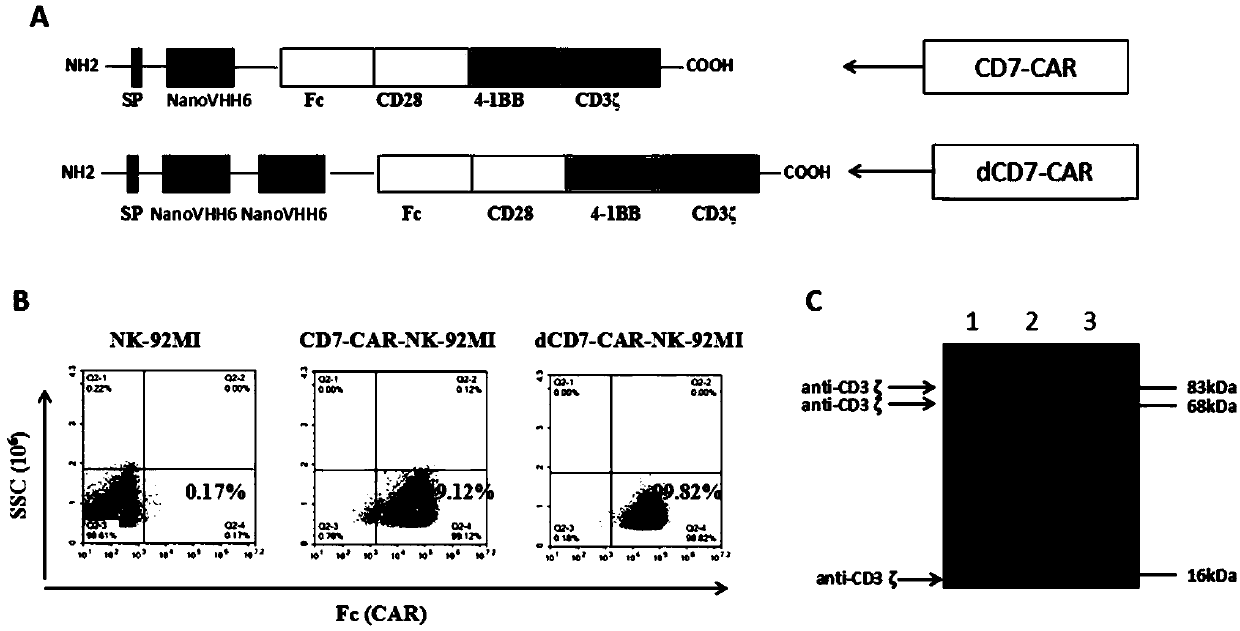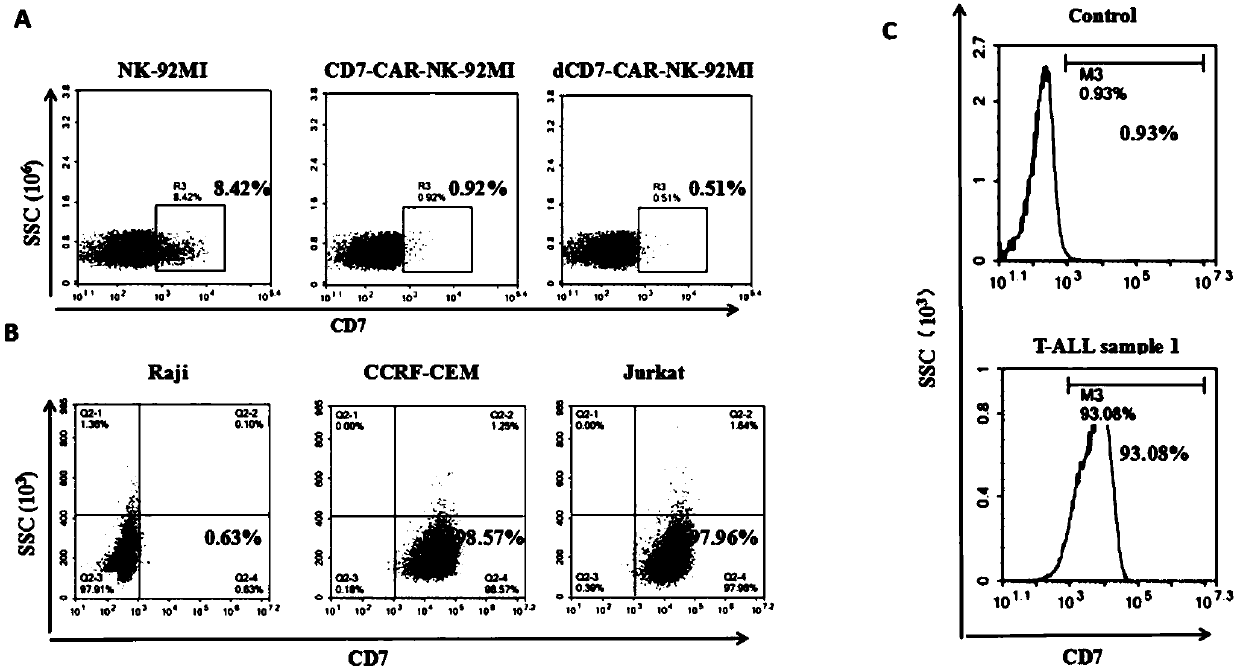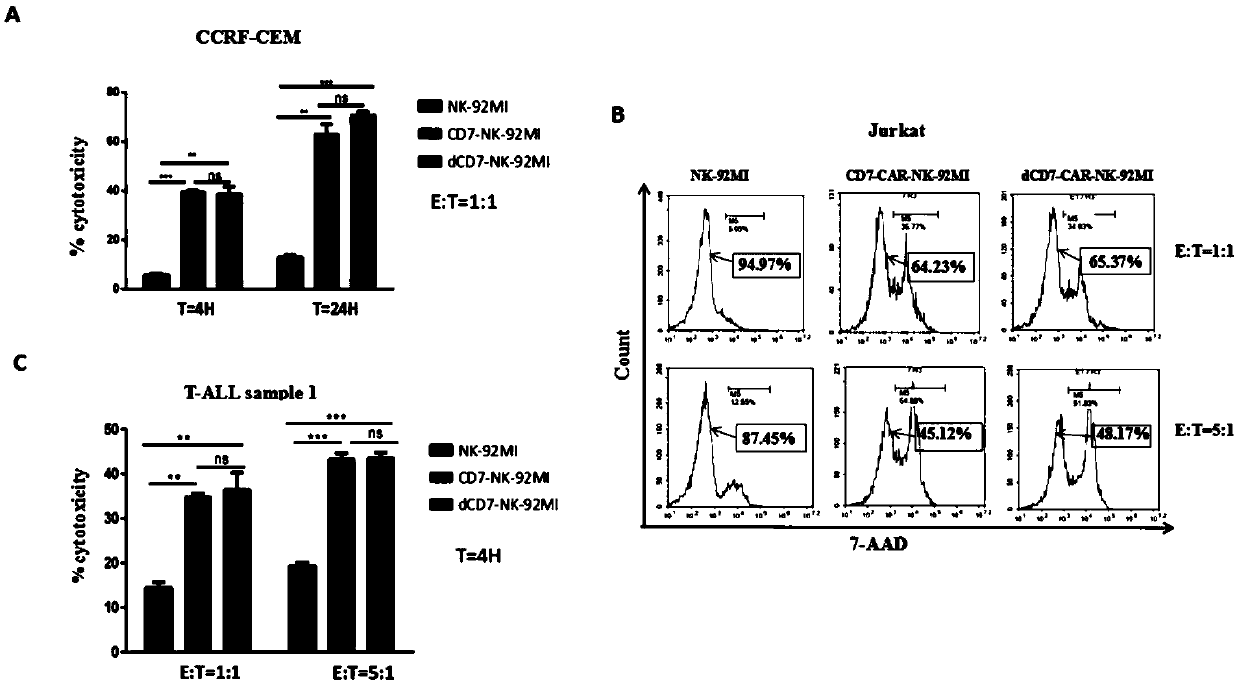CD7 chimeric antigen receptor modified NK-92MI cell and application thereof
A technology of chimeric antigen receptors and NK cells, applied in genetically modified cells, cells modified by introducing foreign genetic material, receptors/cell surface antigens/cell surface determinants, etc., can solve CAR-T cell killing And other issues
- Summary
- Abstract
- Description
- Claims
- Application Information
AI Technical Summary
Problems solved by technology
Method used
Image
Examples
Embodiment 1
[0225] Example 1 Construction of CD7-CAR / dCD7-CAR vector and CAR-NK-92MI cells
[0226] Two CD7-CARs were constructed using the CD7 Nanobody sequence VHH6 monovalent (SEQ ID NO.: 1) and bivalent sequence (SEQ ID NO.: 2). The monovalent CD7-CAR is composed of signal peptide, anti-CD7 Nanobody sequence (VHH6), human Fc hinge region, CD28 transmembrane domain and CD28 and 4-1BB intracellular signaling domains in series with CD3ζ signaling domain. The bivalent dCD7-CAR contains signal peptide, anti-CD7 Nanobody repeat sequence (VHH6-VHH6), human Fc hinge region, CD28 transmembrane domain, and CD28 and 4-1BB intracellular signal transduction in series with CD3ζ signaling domain Structural domain. The structure diagram of CAR is as figure 1 Shown in A. The CD7-CAR and dCD7-CAR sequences were cloned into the pHULK PiggyBac electrotransformation expression vector and named as the CD7-CAR plasmid and dCD7-CAR plasmid, respectively.
[0227] After electroporation, CD7-CAR-NK-92MI and dCD...
Embodiment 2
[0229] Example 2 Expression of CD7 in NK-92MI and T-ALL cells
[0230] The expression of CD7 in NK-92MI, CD7-CAR-NK-92MI and dCD7-CAR-NK-92MI cells was detected by flow cytometry. The results showed that the positive rate of CD7 in NK-92MI cells was 8.42%, while the positive rate of CD7 in NK-92MI cells transfected with CD7-CAR (dCD7-CAR) was less than 1% ( figure 2 A). It shows that CD7-CAR-NK-92MI or dCD7-CAR-NK-92MI cells can specifically kill CD7-positive NK-92MI cells. This example also detected the expression of CD7 on the surface of leukemia cell lines (Jurkat and CCRF-CEM), lymphoblastic cell lines (Raji) and primary tumor cells from T-ALL. The results showed that the CD7 positive rate in CCRF-CEM and Jurkat cells was almost 100% ( figure 2 B), the CD7 positive rate of T-ALL primary tumor cells is 93% ( figure 2 C, the control group is T-ALL cells that have not been incubated with CD7 antibody), while Raji cells are CD7-negative cells ( figure 2 B).
Embodiment 3
[0231] Example 3 In vitro killing activity of CD7-CAR-NK-92MI and dCD7-CAR-NK-92MI cells on T-ALL cell line
[0232] CD7-positive T-ALL cell lines (CCRF-CEM and Jurkat cells) were used to evaluate the in vitro anti-tumor activity of CD7-CAR-NK92-MI and dCD7-CAR-NK92-MI cells. Raji serves as a negative cell line. After co-cultured with CCRF-CEM cells in vitro for 4 hours or 24 hours (effective target ratio 1:1), the cytotoxicity of CD7-CAR-NK92-MI and dCD7-CAR-NK92-MI cells to target cells was detected by flow cytometry. The results showed that compared with control NK92-MI cells, CD7-CAR-NK-92MI and dCD7-CAR-NK-92MI cells showed significant specific cytotoxicity to CCRF-CEM cells under conditions of different effective target ratios. ( image 3 A). This example also evaluated the cytotoxicity of CD7-CAR-NK-92MI and dCD7-CAR-NK-92MI cells to Jurkat cells under the conditions of the effective target ratio of 1:1 and 5:1. The results showed that after 24 hours of incubation with ...
PUM
 Login to View More
Login to View More Abstract
Description
Claims
Application Information
 Login to View More
Login to View More - R&D
- Intellectual Property
- Life Sciences
- Materials
- Tech Scout
- Unparalleled Data Quality
- Higher Quality Content
- 60% Fewer Hallucinations
Browse by: Latest US Patents, China's latest patents, Technical Efficacy Thesaurus, Application Domain, Technology Topic, Popular Technical Reports.
© 2025 PatSnap. All rights reserved.Legal|Privacy policy|Modern Slavery Act Transparency Statement|Sitemap|About US| Contact US: help@patsnap.com



